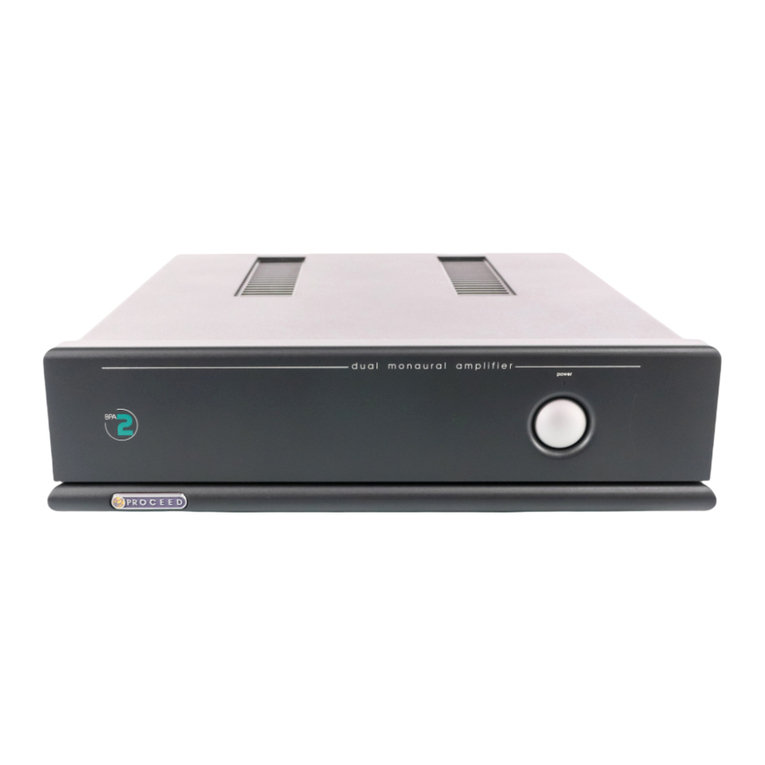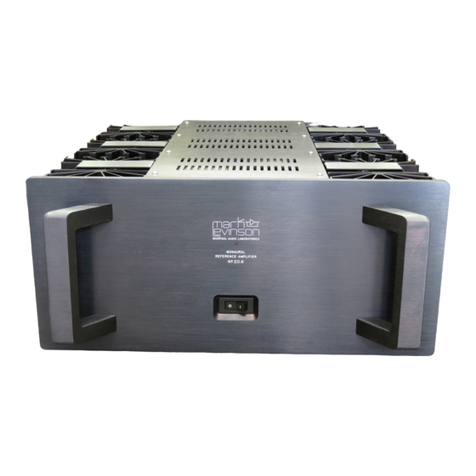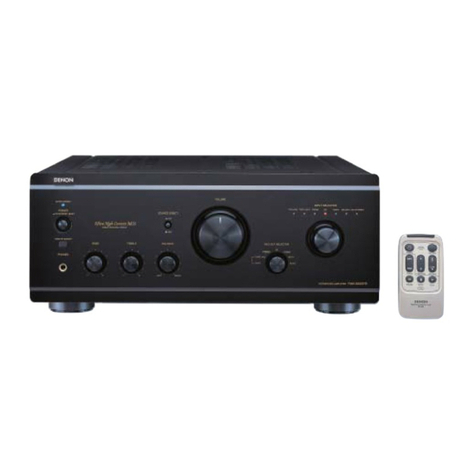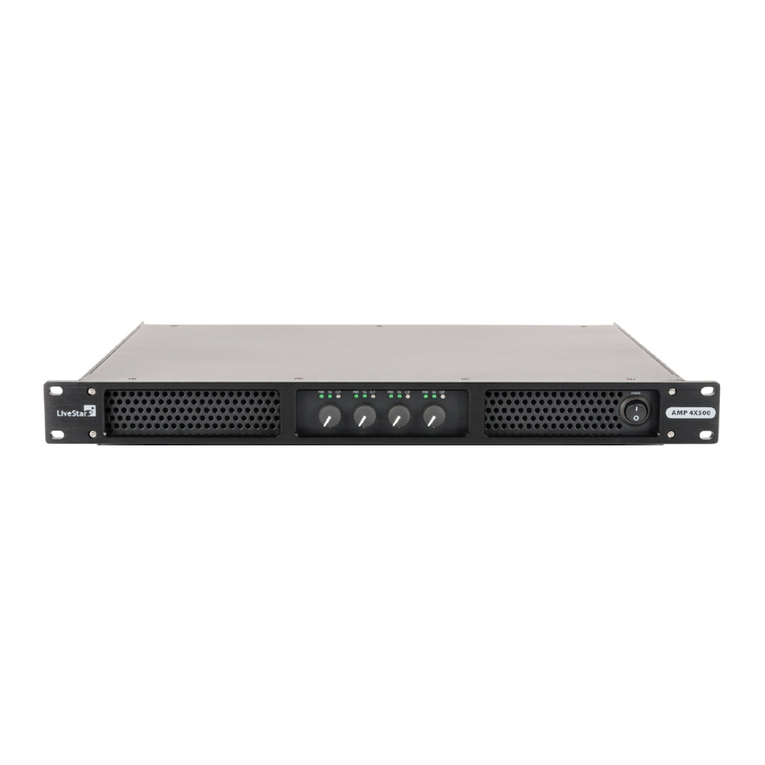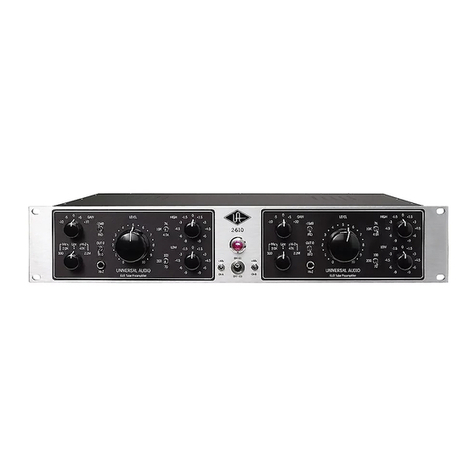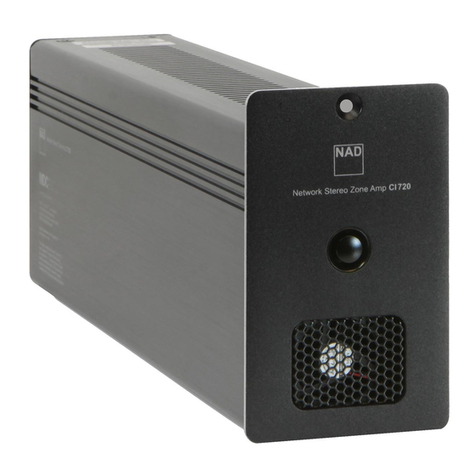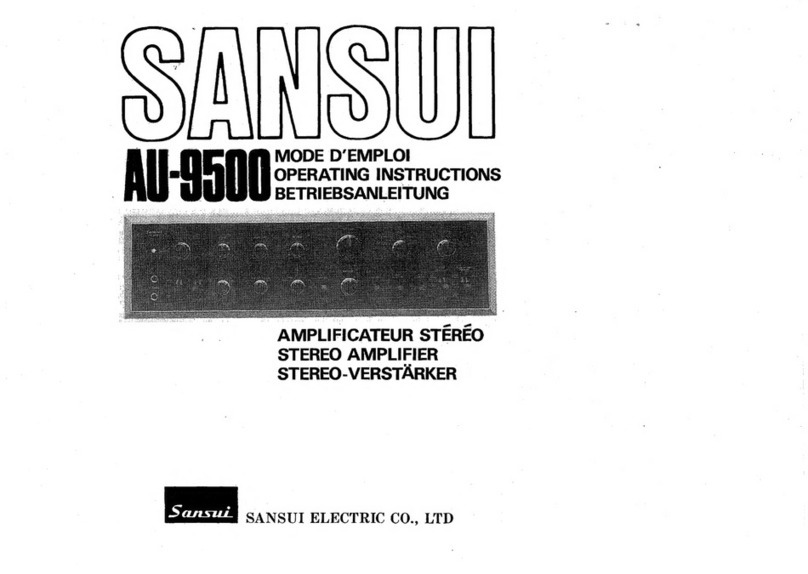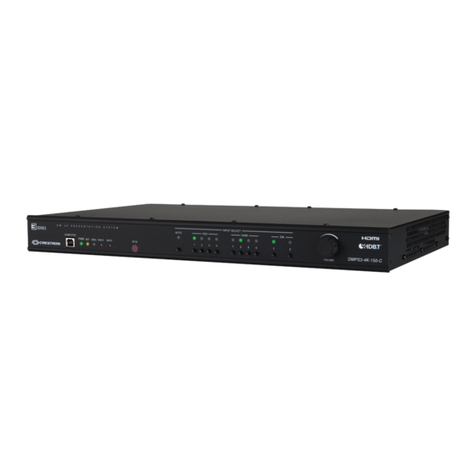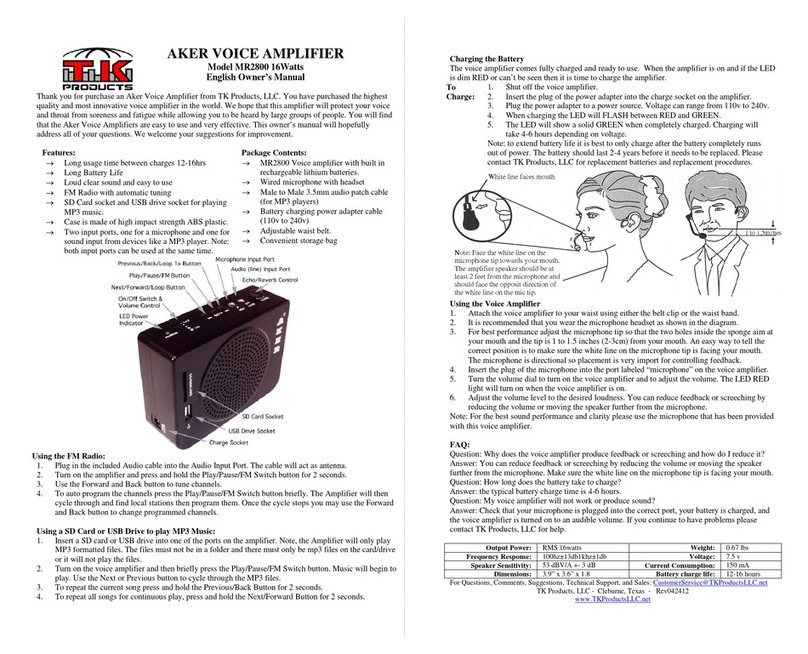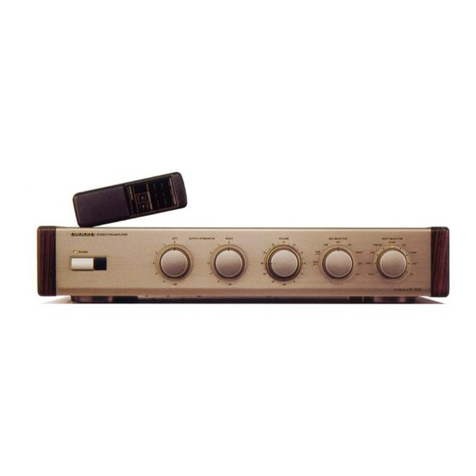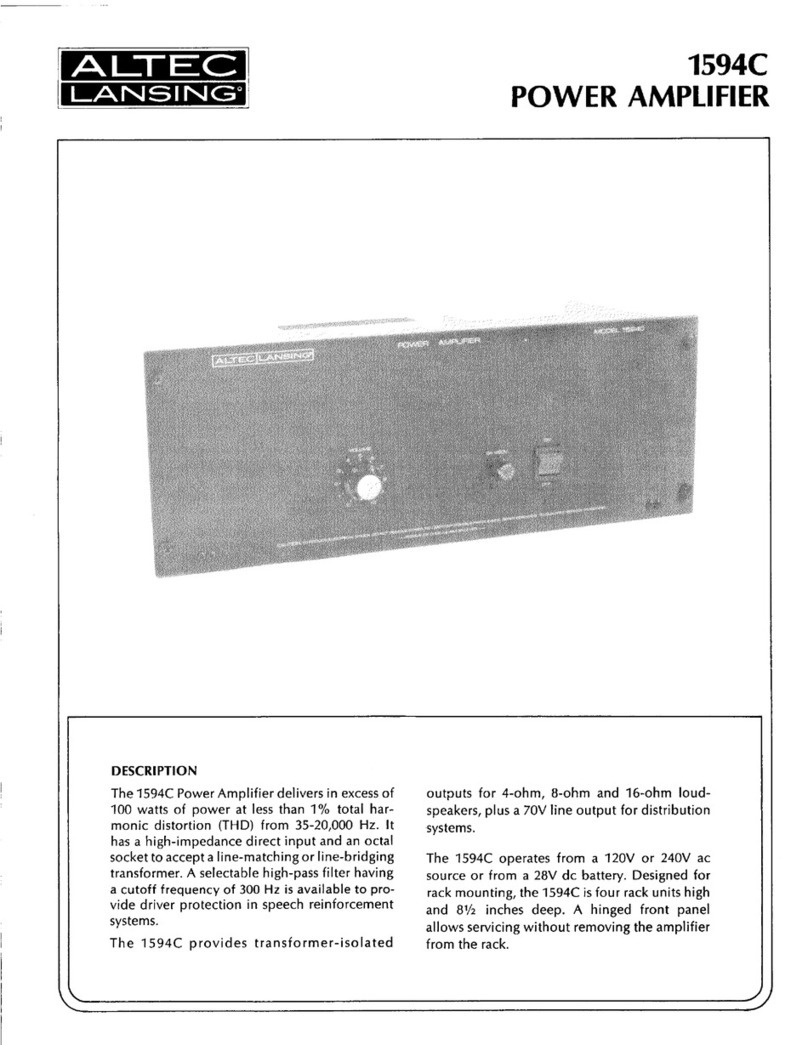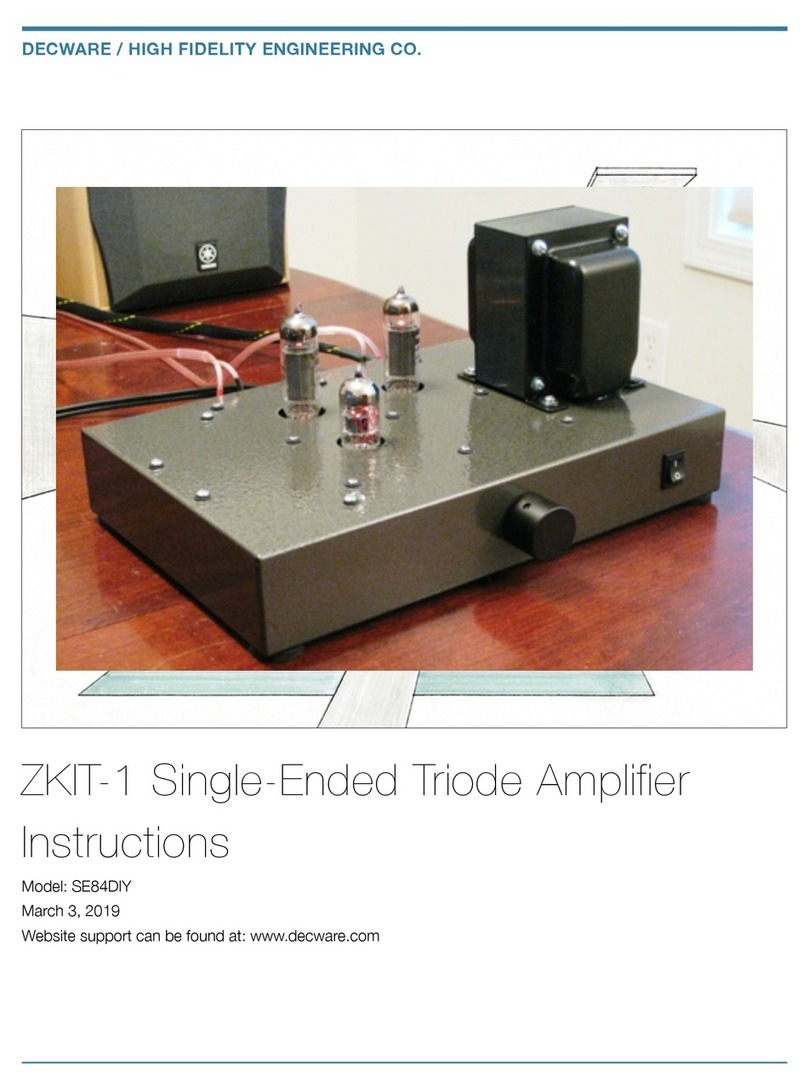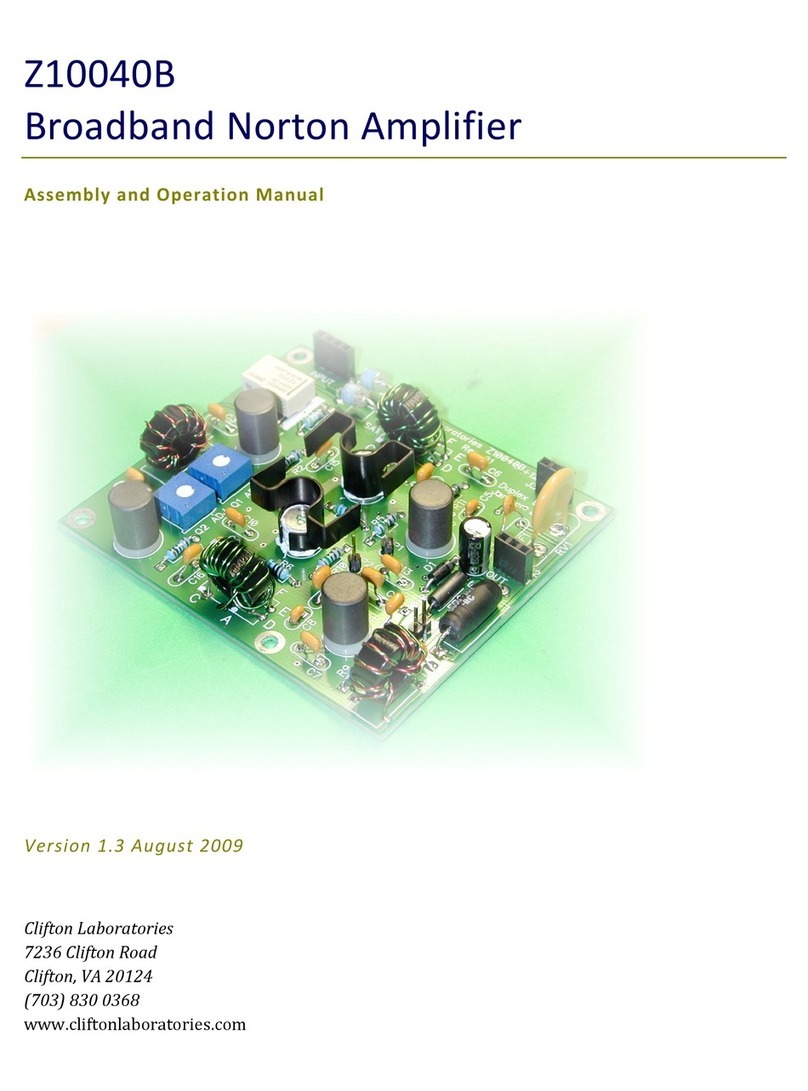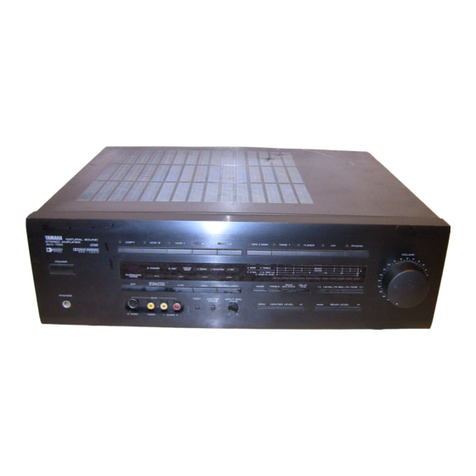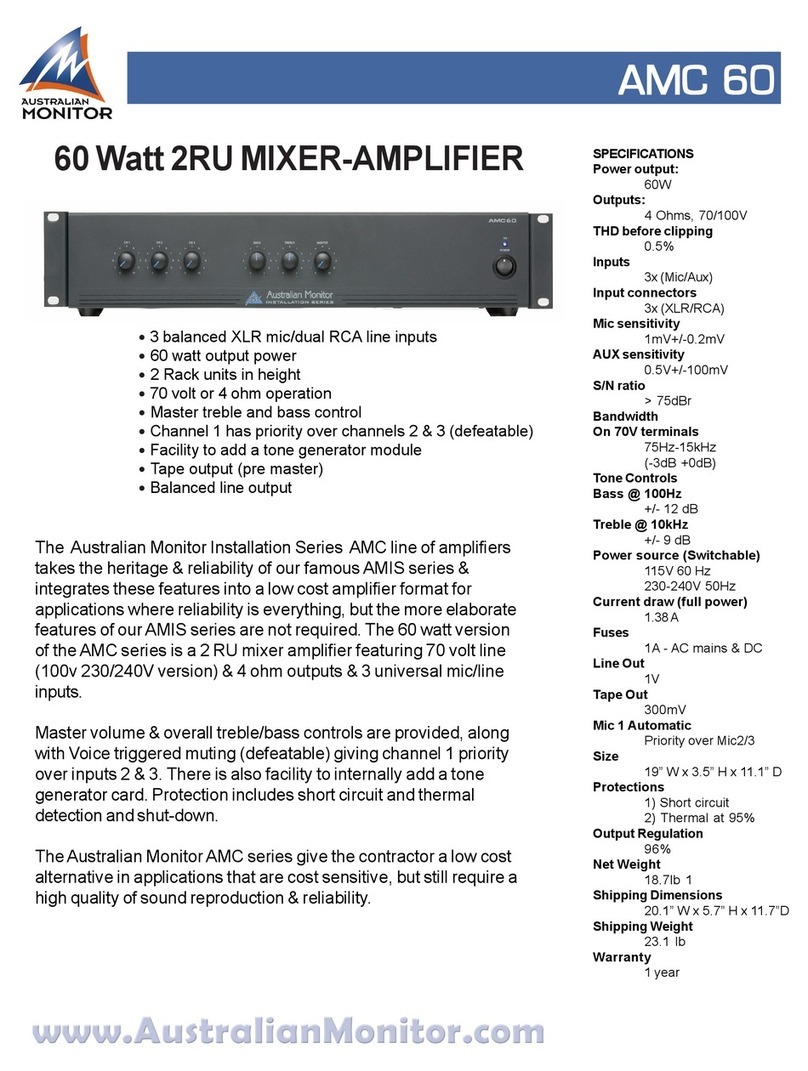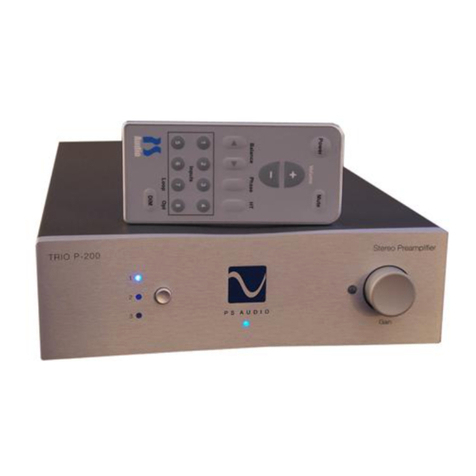Madrigal Audio 23.5 User manual

1
Unpacking and placement
Unpack your Nº23.5 amplifier and keep all packing materials for future
transport. Because of the weight of the unit, handles are provided
front and rear so that two people may lift and carry the amplifier
comfortably and without risk of injury.
Carefully inspect your Nº23.5. If you find any damage or flaws, see
your Mark Levinson dealer immediately.
To keep speaker cables as short as possible, locate the Nº23.5 as close
to the loudspeakers as practical.
The Nº23.5 should be located at least three feet away from the
turntable and preamplifier. Otherwise, the Nº23.5 may induce hum into
these sensitive components.
The Nº23.5 may be placed in a cabinet or on a shelf, but adequate
ventilation must be provided to prevent overheating. The clearance
provided by the unit's feet must be maintained to allow unrestricted air
flow across the heat sinks and through the vents in the bottom of the
chassis (placing the Nº23.5 on thick carpeting, for example, may
reduce or eliminate the clearance provided by the feet). Clearance
above the unit must also be maintained to allow air circulation and to
prevent heat buildup.
The Nº23.5 incorporates thermal sensors located near each group of
output devices. If heat-sink temperature becomes excessive, these
sensors will shut off the amplifier before damage results. After a brief
cooling period, the amplifier can be reactivated via the switch on the
front panel. If this occurs regularly during normal use, it indicates that
the ventilation provided for the amplifier is inadequate. If there's
adequate ventilation and the problem continues, see your Mark
Levinson dealer immediately.
For custom installations and cabinetry, this information may be useful:
■All temperature measurements are made at the top of the heat
sink, 3.5" behind the front plate.
■Normal heat-sink temperature at idle after warm-up, with
unrestricted airflow at 22°C (72°F) ambient temperature: 36.5°C
(97.7°F).
■Maximum permissible heat-sink temperature before thermal
protection is activated: 80°C (176°F).
For exact dimensions, see "Dimensions."
For your protection, review "Important safety instructions" before
you install your Nº23.5.
Unpacking
Placement
Ventilation
Custom installations
PRECAUTION

2
Voltage selection
The Nº23.5 is factory-set (internally) for 100V, 120V, 200V, 220V, or 240V
AC mains operation. Make sure that the label on the rear panel of the
amplifier indicates the correct AC operating voltage for your
location).
If the voltage indicated is incorrect, see your Mark Levinson dealer.
If you wish to change the AC operating voltage of your Nº23.5, see
your Mark Levinson dealer.
A Nº23.5 typically uses from 225W (at idle) to 1200W (at its rated power
into 8Ω). It may be powered by a 15-ampere AC mains line. For
optimum performance into lower-impedance loads, however, it's
recommended that the AC mains outlet used for the Nº23.5 be
capable of supplying a minimum of 20 amperes @ 100V and 120V AC,
and 10 amperes @ 200V, 220V, and 240V AC. If other devices are also
powered from the same AC circuit, their additional power
consumption must be considered.
Two slow-blow 250V 3AG fuses (15 ampere @100V and 120V AC and 8
ampere @200V, 220V, and 240V AC) are located on the rear panel of
the Nº23.5. Replace the fuses only with the same type.
ALWAYS remove the AC cord before removing the fuses.
F
U
S
E
•
F
U
S
E
•
F
U
S
E
•
PUSHPUSH
AC mains fuses
AC connectorOutput (right) Output (left)
Nº23.5
DUAL MONAURAL AMPLIFIER
WARNING:
HAZARDOUS VOLTAGES AVAILABLE INSIDE: DISCONNECT AC~ MAINS CABLE
BEFORE REMOVING ANY COVERS. HIGH ENERGY AVAILABLE AT LOAD
TERMINALS. REFER TO OWNER'S MANUAL FOR PROPER TERMINATION
INSTRUCTIONS. DISCONNECT AMPLIFIER FROM AC~ MAINS BEFORE
REPLACING FUSES.
MAINS FUSES: PLEASE CONSULT OWNER'S MANUAL.
• 90 - 110 VAC~
• 105 - 125 VAC~
• 180 - 220 VAC~
• 210 - 240 VAC~
• 230 - 250 VAC~
• ~47-400 Hz SERIAL NO.
INPUT
BALANCED INPUT
OUTPUT
RIGHT CHANNEL LEFT CHANNEL
+– +–
OPERATING
VOLTAGE:
Voltage indicationShorting strap
Balanced
input (right)
Balanced
input (left)
Single-ended
input (left)
Single-ended
input (right)
Shorting strap
DESIGNED AND MANUFACTURED IN U.S.A. BY
MADRIGAL AUDIO LABORATORIES, INC.
®
F
U
S
E
•
F
U
S
E
•
F
U
S
E
•
Figure 1: Rear panel
PRECAUTION

3
Signal connections
The Nº23.5 incorporates RCA-type and XLR-type connectors for audio
signal input.
The Madrigal-designed RCA-type connectors used for single-ended
audio interconnection are a great improvement over ordinary RCA-
type connectors. The gold-plated XLR-type connectors employed are
of European design, and are made to professional application
standards.
When connecting the Nº23.5 to a preamplifier, we recommend
Madrigal Audio Laboratories HPC Interconnect Cable. HPC
Interconnect Cable is available in various lengths, pre-terminated with
RCA, XLR, and Camac connectors. See your Mark Levinson dealer.
The Nº23.5 can be operated in either single-ended or balanced
mode. In each of these modes, the Nº23.5 can be operated either
normally (non-inverting) or inverting.
Note: This manual describes the connections for single-ended
normal (non-inverting), single-ended inverting, and balanced
normal (non-inverting) operation. If you have questions about
these or other methods of signal connection, see your Mark
Levinson dealer.
Typical audio systems require that the amplifier be of the non-inverting
type. This means that the output signal of the amplifier will be in phase
with the input signal.
For this type of operation, connect the main outputs of your
preamplifier to the left- and right-channel RCA-type inputs (non-
inverting) on the rear panel of the Nº23.5. Be sure that the shorting
strap is inserted into the XLR-type connectors between Pins 1 and 3.
Connectors
Cables
Connection methods and
operating modes
Single-ended normal
(non-inverting) operation
PUSHPUSH
+–
Nº23.5
–+ –+
Left
Loudspeaker
+–
Right
Loudspeaker
From preamplifier main output
Shorting strap
Right
channel
Left
channel
Figure 2: Connections for
single-ended normal
(non-inverting) operation

4
Inverting operation should be used if a phase reversal is required. In
this mode, the output signal of the amplifier will be 180°out-of-phase
with the input signal. This may be required if one component in the
system inverts the signal and absolute phase at the loudspeaker is
desired.
For inverting operation, the main output cables of the preamplifier
must be connected to the XLR-type inputs on the rear panel of the
Nº23.5. The pin assignments of these connectors are:
Pin 1: Signal ground
Pin 2: Signal + (non-inverting)
Pin 3: Signal – (inverting)
Connector ground lug: chassis ground
Connect the XLR-type male line-mount connector to your
preamplifier's main output cable so that signal "hot" (+) connects to Pin
3 and signal ground connects to Pin 1. Be sure to also connect Pin 2 to
Pin 1 inside the XLR-type male line-mount connector with a piece of
copper buss wire (or similar material) at the amplifier end of the cable.
Note: If you prefer not to connect Pin 2 to Pin 1 inside the XLR-
type male line-mount connector, you may purchase pre-
shorted RCA-type inputs from your Mark Levinson dealer. Insert
a pre-shorted RCA-type connector into each RCA-type input
(non-inverting) on the rear panel of the Nº23.5.
After completing the cables, connect the main outputs of your
preamplifier to the left- and right-channel XLR-type inputs on the rear
panel of the Nº23.5. Be sure to remove the shorting strap between Pins
1 and 3 before inserting the output cable connectors.
Single-ended inverting
operation
PUSHPUSH
+–
Nº23.5
–+ –+
Left
Loudspeaker
+–
Right
Loudspeaker
From preamplifier main output
Right
channel
Left
channel
Figure 4: Connections for
single-ended inverting
operation
PUSH
21
3
Figure 3: Female input
connector

5
If your preamplifier is equipped with a balanced main output, it's best
to wire the Nº23.5 for balanced operation, particularly if long lengths
of cable are required between the preamplifier and the Nº23.5. (See
Figure 3 for the pin assignments of the XLR-type inputs on the rear
panel of the Nº23.5.)
Connect the XLR-type male line-mount connector to your
preamplifier's main output cable according to Figure 3, carefully
observing pin assignments. (Refer to your preamplifier's operating
manual to verify that the pin assignments of its output correspond to
the diagram above. If they don't, wire the connector so that the
appropriate output pin connects to the equivalent input pin.)
When complete, connect the main outputs of the preamplifier to the
left- and right-channel XLR-type inputs on the rear panel of the Nº23.5.
Be sure to remove the shorting strap between Pins 1 and 3 before
inserting the output cable connectors.
Balanced normal
(non-inverting) operation
PUSHPUSH
+–
Nº23.5
–+ –+
Left
Loudspeaker
+–
Right
Loudspeaker
From preamplifier main output
Right
channel
Left
channel
Figure 5: Connections for
balanced normal
(non-inverting) operation
Note: For proper balanced operation, no connector (pre-
shorted or otherwise) should be inserted into the RCA-type
inputs on the rear panel of the Nº23.5.

6
Speaker connections
NEVER connect the Nº23.5's output terminals to any device other than
a loudspeaker.
NEVER short-circuit the amplifier output terminals.
NEVER connect the left-channel output terminals to the right-channel
output terminals.
The Nº23.5 is equipped with gold-plated, high-current, five-way
binding posts for output termination to a loudspeaker system. To take
full advantage of the sonic quality of the Nº23.5, we recommend that
you use high-quality speaker cable (see your Mark Levinson dealer).
There are two recommended methods for connecting speaker cables
to the outputs of the Nº23.5. A high-quality spade- or hook-type lug,
soldered to the cable, is preferred.
Spade lug Hook lug
Figure 6: Spade and
hook lugs
Lug connection
Pigtail connection
We confidently recommend Madrigal binding-post lugs, made of
oxygen-free copper with gold-over-silver plating. These lugs are
available for round cable; see your Mark Levinson dealer for more
information.
Note: Many lug connectors are designed to be crimped onto
the cable. However, soldering usually ensures a better electrical
connection. If you have no experience in soldering, see your
Mark Levinson dealer.
The "pigtail" is another method of speaker connection, using a short
piece of 14-gauge wire soldered to the speaker cable. The other end
of this 14-gauge wire is inserted through the hole in the five-way
binding posts on the rear panel of the Nº23.5.
1. Begin with 3" of 14-gauge copper wire.
2. Strip 5/8" of insulation from one end, and strip 1/2" of insulation
from the opposite end.
Figure 7A: Pigtail
connection
5/8"
(15.8mm)
1/2"
(12.7mm)
3"
(76.2mm)
14-gauge wire
PRECAUTION
PRECAUTION
PRECAUTION

7
3. Strip 1/2" of insulation from the speaker cable.
4. Gently slide the (5/8") bare end of the 14-gauge wire into the
center of the bare speaker cable (be careful not to spread the
individual wires of the speaker cable).
5. Solder this connection. A high-wattage soldering gun may be
necessary to provide adequate heat.
6. Lightly "tin" the remaining (1/2") bare end of the 14-gauge wire.
7. Gently slide a 1" length of shrink tubing (5/8"-diameter tubing for
HF10C) over the connection and heat to shrink. (Color-coded
shrink tubing is available for polarity identification.)
Figure 7B: Pigtail
connection
1/2"
(12.7mm)
Speaker cable Solder
Tin
5/8" (15.8mm) shrink tubing
8. Follow this procedure for the remaining speaker connections.
Note: This procedure may also be used for the speaker end of
the cable, depending upon the type of speaker terminal.
When the speaker cables are complete, connect the left-channel +
(positive or red) output post of the Nº23.5 to the + (positive or red)
input terminal of the appropriate loudspeaker.
Connect the left-channel – (negative or black) output post of the
Nº23.5 to the – (negative or black) input terminal of the other
loudspeaker.
Repeat this procedure for the right channel.
Figure 7C: Pigtail
connection
Connecting the speakers

8
Power connection
After making the loudspeaker connections, apply power to your
preamplifier and allow it to stabilize. (Mark Levinson preamplifiers, for
example, require about one minute to stabilize.)
Connect the AC power cord (included in the accessory pack) to the
AC connector on the rear panel of the Nº23.5, then to the AC mains
outlet.
Connecting the
AC power cord
To Nº23.5 To AC mains
1
3
212
3
1= Line (hot)
2 = Neutral
3 = Earth ground
Turn on the Nº23.5 by setting the power switch on the front panel to
the "|" (on) position.
Note: You may hear a transient "click" or "pop" through your
speakers a few seconds after you operate the Nº23.5's power
switch. This noise is normal and won't damage your speakers.
The Nº23.5 won't achieve its sonic potential right away — its sonic
performance is close to the optimum after about 100 hours of use. For
the best performance, you may leave your Nº23.5 powered at all
times, except when you won't be using it for a long period (see
"Important Safety Instructions").
The Nº23.5 is designed to be "power-cycled" (that is, turned on and off)
without affecting its longevity. After the amplifier is turned on after
being left unpowered, allow for about one hour of warmup before
expecting optimal sonic performance.
Under certain conditions (an electrical malfunction or inadequate
ventilation), the Nº23.5's protection circuitry may activate, turning off
the amplifier before damage results. When this happens, the power
switch on the front panel will be set automatically to the "O" (off)
position. After a brief cooling period, you can reactivate the amplifier
by setting the power switch to the "|" (on) position.
If this occurs regularly during normal use, see your Mark Levinson
dealer immediately.
Note: While the protection circuitry is active, the power switch
won't stay in the "|" (on) position. If, after the amplifier has
cooled, the power switch still won't engage, the protection
circuitry still detects a malfunction; see your Mark Levinson
dealer immediately.
Performance tips
Protection circuitry
Figure 8: AC power cord
polarity

9
Bridged operation
When greater power output is desired, the Nº23.5 may be bridged for
monophonic operation into load impedances of at least 2Ω.
Note: Make sure the loudspeaker is rated to handle extremely
high power levels. For example, a bridged Nº23.5 driving an 8Ω
loudspeaker is capable of delivering 800W RMS.
For the best bridged performance, we recommend balanced
interconnection. If your preamplifier provides balanced output, follow
the steps below.
Balanced bridged
operation
PUSHPUSH
–+
Loudspeaker
+–
Nº23.5
–+
From preamplifier
balanced main output
Balanced
bridging cable
Right
channel
Left
channel
Figure 9: Connections for
balanced bridged
operation
1. For balanced bridged operation, you'll need a special three-
ended cable. You may fabricate such a cable according to
Figure 10; it's also available through your Mark Levinson dealer as
part of a balanced bridging kit.
Note: If fabricating the cable, be sure to use high-quality
audio interconnect cable (such as Madrigal HPC).
Connect the bridging cable's female XLR-type connector to the
appropriate channel of your preamplifier's balanced main
output.

10
21
3
21
3
Signal ground (shield)
Left-channel
XLR male
line-mount
(rear view)
Twisted pair
Right-channel
XLR male
line-mount
(rear view)
12
3
XLR female
line-mount
(rear view)
Twisted pair
Signal ground
(shield)
Figure 10: Balanced
bridging cable
2. Connect the bridging cable's male XLR-type connectors to the
Nº23.5's left- and right-channel XLR-type input connectors, taking
care to insert the correct cable end into its designated channel.
3. Connect the left-channel +(positive or red) output post of the
Nº23.5 to the +(positive or red) input terminal of the appropriate
loudspeaker. Connect the right-channel +(positive or red) output
post of the Nº23.5 to the –(negative or black) input terminal of
the same loudspeaker.
4. Repeat this procedure for the other Nº23.5 to be bridged.
If your preamplifier provides only single-ended output, follow the steps
below.
Single-ended
bridged operation
PUSHPUSH
–+
Loudspeaker
+–
Nº23.5
–+
From preamplifier
single-ended main output
Bridging cable
Right
channel
Left
channel
Figure 11: Connections for
single-ended bridged
operation
1. Connect the appropriate channel of your preamplifier's single-
ended main output to the left-channel RCA-type input on the
rear panel of the Nº23.5.

11
2. Connect the bridging cable between the left- and right-channel
XLR-type input connectors, taking care to insert the correct cable
end into its designated channel. You may fabricate such a cable
according to Figure 12; it's also available through your Mark
Levinson dealer as part of a single-ended bridging kit.
Figure 12: Single-ended
bridging cable
21
3
Left-channel
XLR male
line-mount
(rear view)
21
3
Signal ground (shield)
Right-channel
XLR male
line-mount
(rear view)
Signal hot (center conductor)
22-guage
buss wire
22-guage
buss wire
Note: If fabricating the bridging cable, be sure to use high-
quality audio interconnect cable (such as Madrigal HPC).
3. Connect the left-channel +(positive or red) output post of the
Nº23.5 to the +(positive or red) input terminal of the appropriate
loudspeaker. Connect the right-channel +(positive or red) output
post of the Nº23.5 to the -(negative or black) input terminal of
the same loudspeaker.
4. Repeat this procedure for the other Nº23.5 to be bridged.

12
Care and maintenance
To remove dust from the cabinet of the Nº23.5, use a feather duster. To
remove dirt and fingerprints, we recommend isopropyl alcohol and a
soft cloth.
Poor connections cause sonic degradation. We recommend,
therefore, that you clean all speaker connection with denatured
alcohol at least once a year. See your Mark Levinson dealer for other
ways to optimize connections.
Two slow-blow 250V 3AG fuses (15 ampere @100V and 120V AC and 8
ampere @200V, 220V, and 240V AC) are located on the rear panel of
the Nº23.5. Replace the fuses only with the same type.
ALWAYS remove the AC cord before removing the fuses.
Cleaning
Fuses
PRECAUTION

13
Specifications
The correlation between published specifications and sonic quality is
unreliable. A list of numbers reveals virtually nothing. All technical
measurements must be subject to qualitative as well as quantitative
interpretation.
Measurements of the Nº23.5 yield excellent results by any standards.
However, only those specifications that apply to the actual operation
of the amplifier are included here.
■Rated power: 200W minimum continuous sine wave power into 8Ω,
with both channels driven from 20Hz to 20KHz with no more than
0.1% THD (FTC). 400W minimum continuous sine wave power into 4Ω
with both channels driven from 20Hz to 20KHz with no more than
0.2% THD (FTC).
■Peak output voltage: 67V @ rated line voltage @ 8Ω
■Frequency response: (-3dB) 4Hz, 140KHz
■Input impedance: 50KΩshunted by 1.5nF
■Voltage gain: 26.9dB
■Power consumption: Typically 225W @ idle; 1200W @ rated power,
8Ω
■Overall dimensions: See "Dimensions"
■Shipping weight: 105 lbs. (48kg)
■Connector complement: 2 RCA-type connectors
2 XLR-type connectors
4 five-way binding posts
1 IEC mains connector
For more information, see your Mark Levinson dealer or:
Madrigal Audio Laboratories, Inc.
2081 South Main Street (Route 17), P. O. Box 781
Middletown, Connecticut 06457 U.S.A.
Telephone: (203) 346-0896 or 344-9300
FAX: (203) 346-1540
If purchased in North America, this Mark Levinson product’s warranty is owner-transferable.
Warranty conditions are valid only in the country where the product was originally purchased.
For warranty information and conditions on products purchased outside of North America,
contact your local dealer or regional distributor.

14
Dimensions
14-3⁄16"
(360.3)
2-1⁄2"
(63.5)
13"
(330.2)
18-7⁄8"
(479.4)
2-1⁄2"
(63.5)
7-27/32"
(198.9)
5-3/4"
(146)
6-5/16"
(160) 7-5/8"
(193.8)
19"
(482.6)
1-3⁄4"
(44.4)
1-3⁄4"
(44.4)
1" TYP.
(25.4)
1⁄2" TYP.
(12.7)
4-3⁄16"
(122.5)
29⁄32"
(22.9)
5⁄8"
(15.9)
3⁄8"
(9.5)
3⁄8"
(9.5)
23/32"
(18)
5/8"
(15.9)
7/64"
(2.8)
1-3/64"
(26.4)
1-1⁄2"
(38.1)
Figure 13A: Dimensions,
Nº23.5, top view
Figure 13B: Dimensions,
Nº23.5, side view

15

16
630095-1 Printed in U.S.A.
© 9/1993 Madrigal Audio Laboratories, Inc. All rights reserved.
®
Madrigal Audio Laboratories, Inc.
2081 South Main Street, P.O. Box 781
Middletown, Connecticut 06457 USA
Telephone: (203) 346-0896 or 344-9300
Fax: (203) 346-1540
is a registered trademark of Madrigal Audio Laboratories, Inc.
Table of contents
Other Madrigal Audio Amplifier manuals

